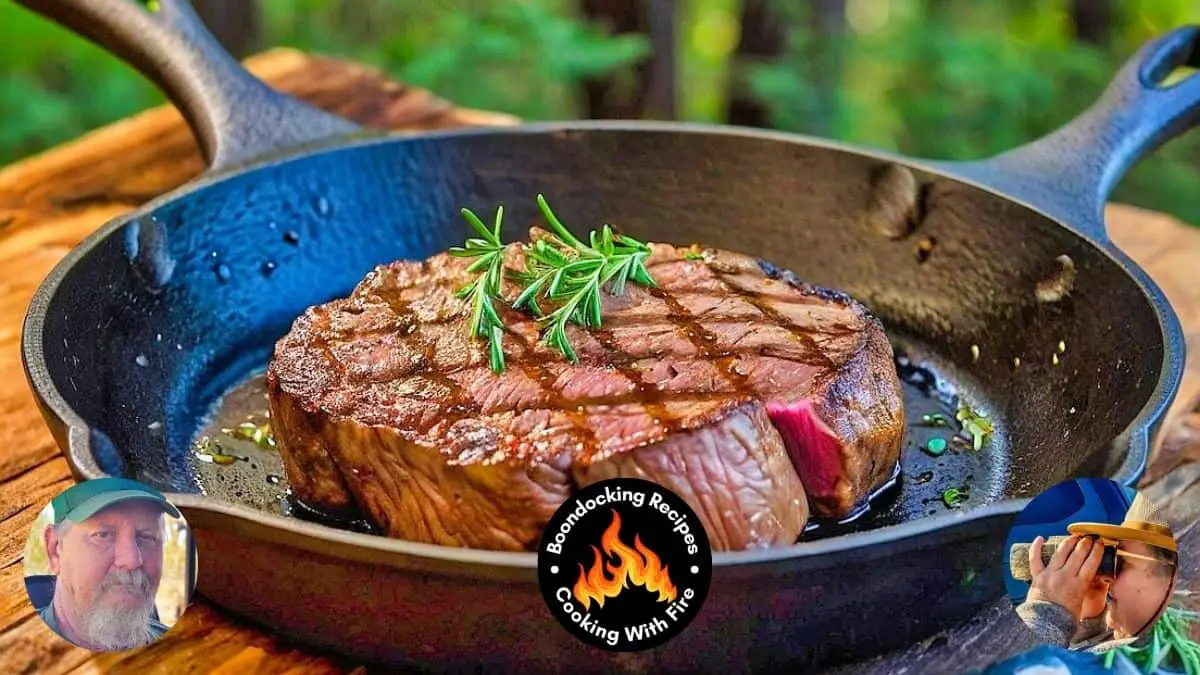
Bison cast iron skillet filet mignon is my go-to dish when my husband and I want a special dinner outdoor. When we’re camping or just spending a quiet evening at home, Bison cast iron skillet filet mignon is a special occasion item on the menu. There’s something special about cooking over an open flame that makes this dish better than a grill or stove at home.
My husband swears by the smoky flavor the cast iron skillet gives the filet mignon, and I have to agree – it’s a total winner. We’ve tried cooking this dish on the grill, but it’s just not the same as using a cast iron skillet. There’s something about the way the iron distributes heat that makes the filet mignon cook evenly and get that perfect sear. And let’s be real, there’s nothing quite like the sound of sizzling meat on a cast iron skillet!
Bison filet mignons are an easy meal to prepare. There’s something special about eating under the open sky that makes the experience feel special
We are big fans of Bison meat and this recipe lets the flavors of the meat shine through. We’ve tried cooking other types of steak in the cast iron skillet, but Bison is definitely our favorite. There’s something about the leaner meat that makes it perfect for grilling or pan-frying – it always comes out tender and juicy.
Summing up, Bison cast iron skillet filet mignon is a recipe that’s become a staple in our outdoor cooking list. Whether we’re camping, glamping, or just enjoying a quiet evening at home, this dish never fails to hit the spot.
Cooking Instructions For the Bison Cast Iron Skillet Filet Mignon
- The first step of making the Bison cast iron skillet filet mignon is to start your fire or charcoals. You will using them for the Bison cast iron skillet filet mignon, so you will want to make sure you have plenty on hand.
- If using embers, get a large fire going using (preferably) hardwood and let it slowly burn down. This process from start to finish can take upwards of an hour.
- If using charcoals, fill a large chimney starter and light. This process will take approximately 20 minutes to get all the coals hot and ready. You will likely want to have some charcoals available in reserve.
- Add a flat fire great on top of the embers for cooking
- Allow 30 minutes for the bison tenderloin filets to come to room temperature before cooking.
- Season the top, bottom, and sides of the two filets with sea salt and season with finely crushed peppercorn. For optimal results, roll the filets gently in all directions to remove any excess salt on the cutting board. Gently rub the pepper and salt into the fillet.
- Gather all of the herbs into a ball and secure them with butcher string. To keep the bundle from bursting while cooking, tie knots at the ends.
- In a cast-iron skillet set over high heat, add the butter. After the butter has melted and is foamy, throw in the bison fillets and basil bunch. Cook the filets in a skillet over medium heat until they begin to develop a crust that is golden brown.
- Distribute the butter from the pan evenly over the surface of each steak. Cook the filet mignon for 2-3 minutes per side for rare, 3-4 minutes per side for medium rare, and 5-6 minutes per side for well-done, flipping every minute or two. For juicy, tender bison, cook it to a rare to medium rare doneness.
- Take the bison fillets out of the pan once they’ve cooked and let them rest for 15 minutes. Kill the bunch of herbs.
- In the meantime, add the other two tablespoons of butter to the skillet without cleaning it. Once melted, include the sea salt and peppercorns that have been roughly crushed. After three or four minutes of sautéing, the peppercorns should be crunchy.
- The Worcestershire sauce and dry vermouth should be added next. After a short while, add the heavy cream and continue simmering. Reduce heat to low and simmer, stirring occasionally, until mixture thickens, approximately 10 minutes.
- Top the steaks with a dollop of peppercorn sauce, which is creamy and flavorful. Mash potatoes and roasted broccoli make a tasty side dish. Have fun!
Ingredients
bison filet mignon
sea salt,
peppercorns
rosemary
sage, fresh
fresh thyme
butter
dry vermouth
heavy cream
Worcestershire sauce
peppercorns
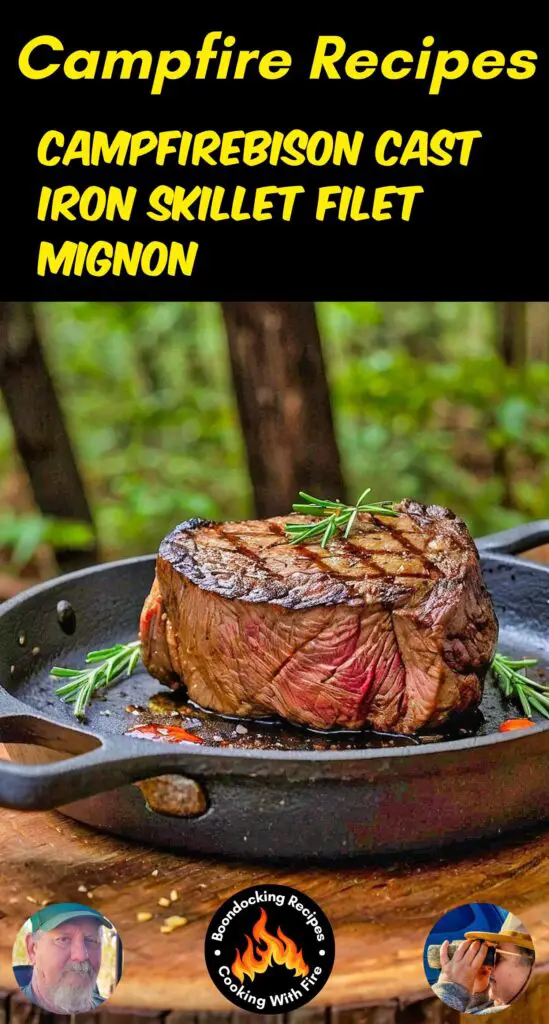
5 Reasons I Love the Bison Cast Iron Skillet Filet Mignon
1. It is delicious
If you like meat, you will like Bison. People describe Bison meat as tasting comparable to beef but richer and somewhat sweeter. However, because bison is so thin, it is crucial not to overcook it. Bison should not be cooked beyond medium. Of course, if you use ground Bison, this isn’t an issue.
Some people are afraid that Bison will have a gamey flavor comparable to venison; however, I have never found this to be the case. Bison, in my opinion, tastes better than any meat I’ve ever tasted. Bison meat is denser, richer in flavor, and more satisfying than beef, in my opinion.
2. Lean Protein
Food guidelines advocate bison as a lean protein alongside skinless chicken breast and other wild game meats, and for good reason. 100g of lean bison contains just 2.42g of fat, compared to 8.09g in lean beef and 9.66g in lean pig. The same 100g of bison contains just 82mg of cholesterol, compared to 86mg in the same quantity of lean beef, pig, and chicken. If you want to keep things lean and clean, Bison is an excellent choice. Figures sourced from the Canadian Bison Association website.
3. Lot’s of the Good Stuff Inside
In addition to being lean as well as low in cholesterol, bison is high in iron (3.42mg per 100g lean meat compared to 2.99mg in beef, 1.1mg in pork, 0.6mg in chicken, and.34mg in salmon), vitamin B12, B6, Niacin, and Zinc. Bison’s high iron content makes it an ideal choice for both men and women who suffer from anemia. In 2018, Thehealthy.com (part of Reader’s Digest) identified bison as one of the 13 Superfoods Every Healthy Woman Needs in Her Diet because women are more susceptible to anemia, and bison delivers a high iron, low-fat choice to help address this issue.
Bison are raised without growth stimulants or hormones and are not regularly fed antibiotics.
4. It’s Sustainable
Bison are raised sustainably, contributing to the land’s development and biodiversity rather than depleting it. Because practically all of a bison’s nutritional demands can be supplied by *feeding on native perennial plants that grow natively in Canada, there is no need to overfertilize the soil. These grassland ecosystems would often be exploited for monoculture cultivation, such as grain or soybeans. Some monoculture farms have even been turned into more biodiverse bison grazing areas.
Raising a bison cow and her young requires between four and sixteen hectares of grazing space. However, bison live on, consume, and fertilize these enormous grasslands. Compare this to other commercial farming approaches that confine animals to limited quarters and raise their feed on monoculture farms. To be sustainable, these monoculture agricultural processes require a lot of acreage and artificial fertilizers. Of course, the feed must be moved from the farm to the animals.
5. You Already Know What To Do With It
One might be telling yourself, “This seems wonderful, but what do I do with it?” That is an excellent question. But here’s the thing: You are already aware of what to do with it. Let me ask you something: Have you ever cooked beef? If you said yes, you have your answer. You may make the same dishes you’ve always used; just substitute Bison for the protein. It is that easy.
Bison, The Meat of The Future.
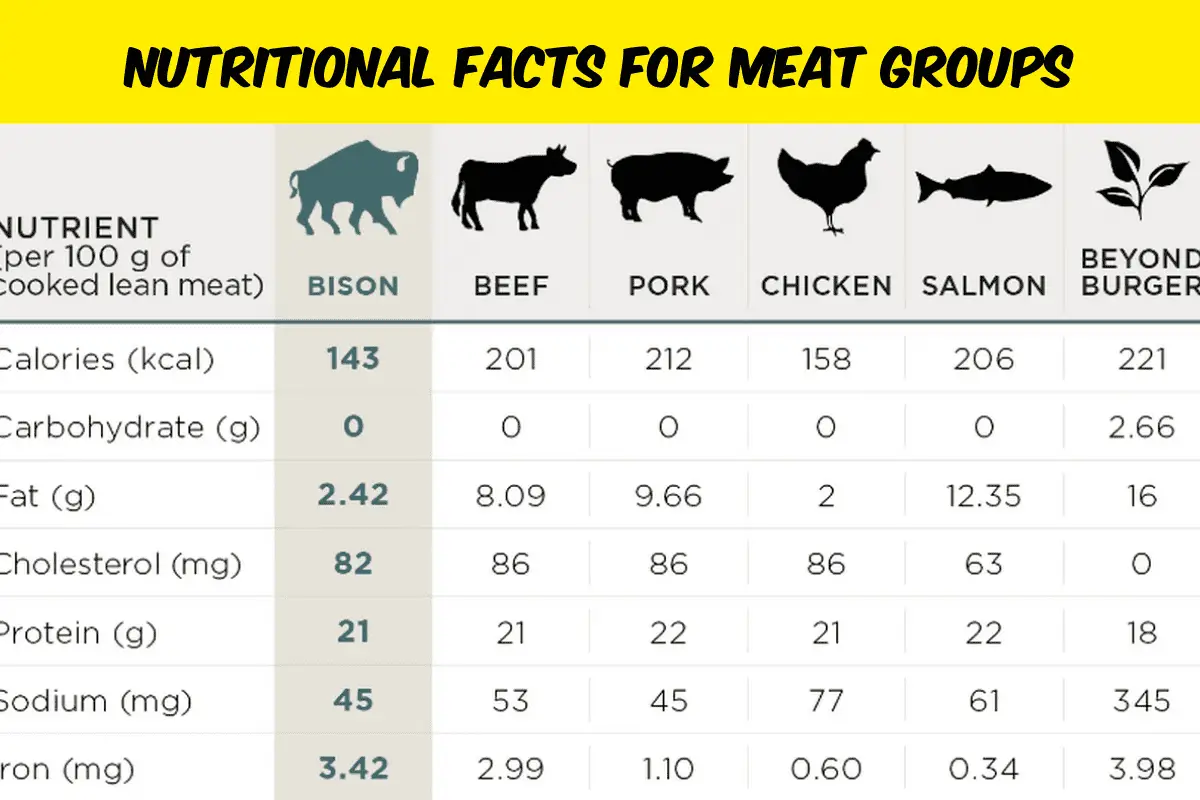
Nutritional Facts for Meat Groups
I’ve been cooking with bison for more than a decade, at private dinners, and at home, and I’ve always liked it. An observation that has impressed me over the years is that bison ought to be more widely recognized than it is, and I believe it is about to be. I believe that as consumers seek for more sustainable meals and leaner meats, bison will gain appeal. There is a growing trend, and for good cause, of eating higher quality meat in lesser quantities. Bison, with its high caloric density and unquestionable quality, is the ideal protein for this future dietary standard.
If you’ve ever spotted Bison at the grocery store, thought about it, but then passed it up because you didn’t know what to do with it or how it would taste, I hope this has given you a reason to reconsider. I hope you try it because I am convinced that you will be pleased with the results.
Grass-fed, regenerative bison meat is superior in flavor, protein content, and nutritional density. Bison is a lean, soft, naturally tasty meat with a deeper taste profile and darker color than beef. Bison meat, unlike that of other exotic species, lacks a “gamey” or wild flavor and is typically thought to be sweeter. Bison meat is interchangeable in almost any red meat dish.
Bison steaks cook around 1/3 faster than beef steaks due to their thinner nature. Bison steaks are best cooked medium-rare (135°F)/medium (145°F) to keep the meat’s moisture and taste – this means taking the meat off the fire when it is approximately 5 to 10 degrees below your ideal temperature to account for the rise in temperature while it rests.
Bison Cooking Guidelines
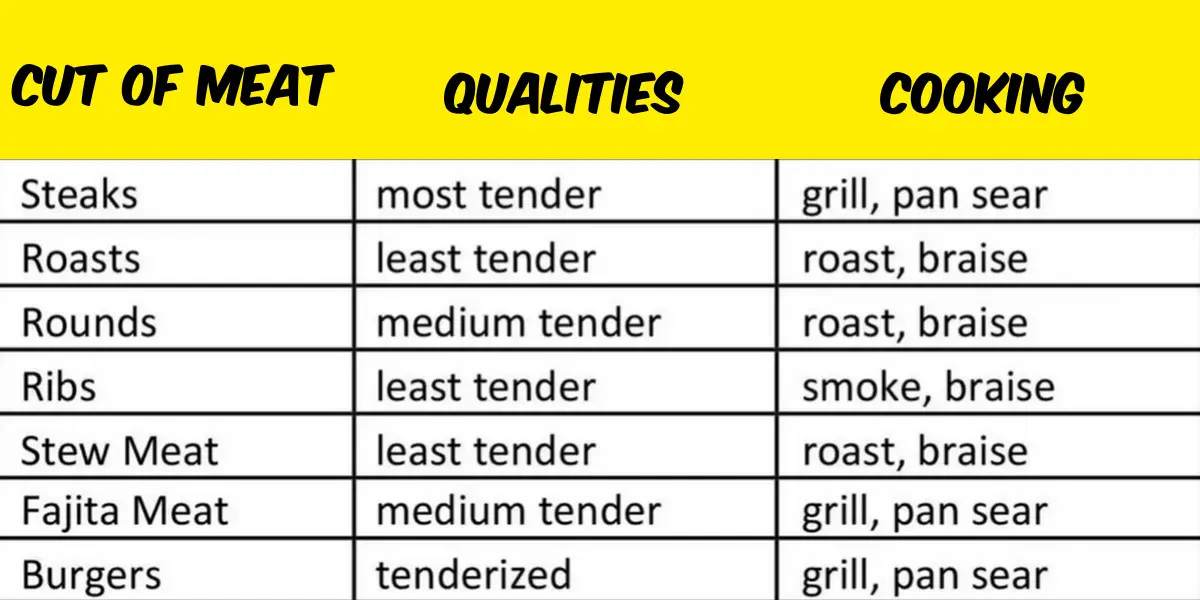
Chart Showing Various Cuts of Bison
Steaks (Grill, Broil, or Pan-Broil)
Use steak ¾ to 1 inch thick
Place in lightly oiled skillet and use medium heat on stove top
Place bison on BBQ or 6 inches from the heat source in broiler
Cook 4 – 5 minutes per side
To increase tenderness, marinate sirloin tip and inside round steaks for 8- 24 hours
Roasts (Sirloin Tip, Inside Round)
Sear roast in oven at 500°F (260°C) or on stove in a hot pan
Season roast, add ¼ cup (50 mL) of liquid (water or red wine)
Roast at 325°F (165°C) in covered pan or place in slow cooker
Cook roast to medium rare 145°F (63°C)
Roasts (Rib, Loin and Tenderloin)
Use uncovered pan with rack
Season as desired to taste
Cook at 275°F (135°C)
Do not cook past medium 155°F (68°C)
Burger
Cook ground meats to 160°F (70°C) internal temperature
Make sure all patties sit flat on grill for entire cooking time.
Cooking equipment should maintain temperature of 375°F (190°C) even when loading continuously with frozen patties
Ground bison should always be cooked until no pink remains
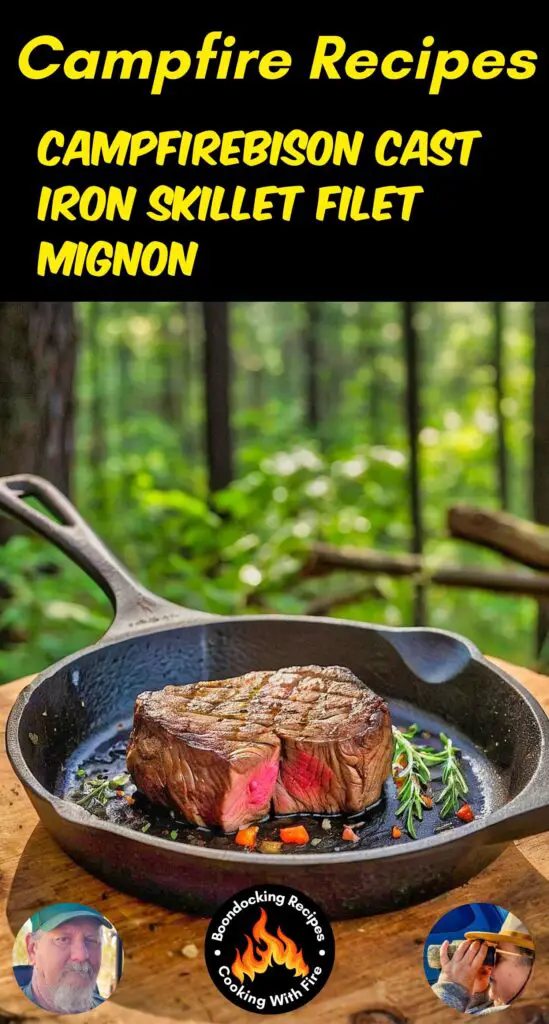
Natural versus Organic—Bison Meat is Meat Raised Naturally
The term ‘natural’ does not mean the same as certified organic. Under Canadian labelling guidelines, a ‘natural’ or ‘naturally raised’ label claim is allowed only if animals were raised with minimal human intervention, such as bison. While we can’t claim our bison meat as certified organic, we can say that our products are about as natural and unprocessed as you can get.
Bison Meat Benefits
Bison meat is one healthy protein, but don’t just take our word for it. The U.S. and Canada’s food guides recommends bison meat as a ‘heart healthy lean protein’ for anyone, and many nutritional experts tout bison as ‘a step above beef when it comes to sustainability, heart health and even taste.’ Nutrient-dense bison meat is healthy because it’s:
Bison is lean meat with a similar texture, flavor, and appearance to beef, but its impressive nutrient profile uniquely supports an active lifestyle. With no carbs, only 2.1g of fat, and a whopping 24 grams of high-quality protein per serving, the health benefits of bison meat are extensive.
Promotes Muscle Recovery
The main appeal of bison is its high quality protein content. . Protein is essential for helping your muscles recover from a tough workout. With the high-quality protein that bison contains, your body can use it for muscle synthesis and utilize the naturally-occurring vitamins and minerals to support overall health.
Supports Bone Strength
Protein has been shown to have a positive association with bone strength, especially within the senior demographic. With bison possessing a very pure and high-quality source of protein, regularly consuming this lean meat can help improve muscle mass and bone strength, keeping individuals—particularly seniors—active and independent.
Great Source of Zinc
Just a 4-ounce bison patty can provide over 3 milligrams of zinc—an essential mineral for your immune system, metabolism, and healing wounds. Zinc from meat sources, such as bison, is more bioavailable than from vegetarian sources, which means that bison provides a form of zinc that’s easy for your body to absorb and utilize in the body.
Preventative Against Anemia
Anemia is associated with low intake or poor absorption of vitamin B12. Since bison is a good source of iron and vitamin B12, consuming it can help you avoid becoming anemic and experiencing symptoms of anemia such as fatigue, dizziness, paleness, and a rapid heart rate.

FAQ For the Bison Cast Iron Skillet Filet Mignon
Q: What ingredients are needed for the easy Bison cast iron skillet filet mignon recipe?
A: To make the easy Bison cast iron skillet filet mignon recipe, you’ll need bison filet mignon steaks, olive oil or butter, salt, pepper, garlic, fresh thyme or rosemary, and optional ingredients such as a splash of red wine or beef broth for deglazing.
Q: How do you prepare the bison filet mignon for the easy Bison cast iron skillet filet mignon recipe?
A: For the easy Bison cast iron skillet filet mignon recipe, start by bringing the bison steaks to room temperature. Pat the steaks dry with paper towels and season generously with salt and pepper on both sides.
Q: What is the cooking process for the easy Bison cast iron skillet filet mignon recipe?
A: To cook the easy Bison cast iron skillet filet mignon recipe, heat a cast iron skillet over medium-high heat and add olive oil or butter. Once hot, place the bison steaks in the skillet and sear for 3-4 minutes on each side, or until a crust forms. Add garlic and fresh herbs to the skillet and baste the steaks with the melted butter or oil. Reduce heat and cook to desired doneness (internal temperature of 130°F for medium-rare).
Q: How do you ensure the bison filet mignon is cooked to the correct doneness in the easy Bison cast iron skillet filet mignon recipe?
A: Use a meat thermometer to check the internal temperature of the steaks in the easy Bison cast iron skillet filet mignon recipe. For medium-rare, aim for an internal temperature of 130°F (54°C). Allow the steaks to rest for 5 minutes before serving to ensure juices are evenly distributed.
Q: What side dishes pair well with the easy Bison cast iron skillet filet mignon recipe?
A: The easy Bison cast iron skillet filet mignon recipe pairs well with a variety of side dishes. Consider serving it with roasted or mashed potatoes, sautéed mushrooms, steamed asparagus, or a fresh green salad. Other excellent options include a side of creamy polenta or a light vegetable medley.
Other Bison Recipes to Try
Bison Tomahawk Steak and Chimichurri Butter
Bison Tenderloin with Horseradish Cream
Easy Smoked Bison Brisket Recipe
Carne Asada Bison Tacos with Salsa Verde
Beer Braised Bison Bratwurst and Sauerkraut

Bison Cast Iron Skillet Filet Mignon
Equipment
- Kitchen Twine
- mixing bowl
- Cast Iron Skillet
- Grill Grate
- knives
- Campfire Cooking Utensils
- Campfire Serving Utensils
- Campfire Fork Or Tongs
- fire proof cooking gloves
- Cast Iron Dutch Oven
- Foil Paper Non Stick
Ingredients
- 2 bison filet mignon cuts
- 2 tbsp sea salt coarse
- 2 tbsp peppercorns finely crushed
- 2 sprigs rosemary fresh
- 2 sprigs sage fresh
- 2 sprigs fresh thyme fresh
- 6 tbsp butter
- 1/2 cup dry vermouth
- 1 cup heavy cream
- 1 tbsp Worcestershire sauce
- 2 tbsp peppercorns roughly crushed
Instructions
- The first step of making the Bison cast iron skillet filet mignon is to start your fire or charcoals. You will using them for the Bison cast iron skillet filet mignon, so you will want to make sure you have plenty on hand.
- If using embers, get a large fire going using (preferably) hardwood and let it slowly burn down. This process from start to finish can take upwards of an hour.
- If using charcoals, fill a large chimney starter and light. This process will take approximately 20 minutes to get all the coals hot and ready. You will likely want to have some charcoals available in reserve.
- Add a flat fire great on top of the embers for cooking
- Allow 30 minutes for the bison tenderloin filets to come to room temperature before cooking.
- Season the top, bottom, and sides of the two filets with sea salt and season with finely crushed peppercorn. For optimal results, roll the filets gently in all directions to remove any excess salt on the cutting board. Gently rub the pepper and salt into the fillet.
- Gather all of the herbs into a ball and secure them with butcher string. To keep the bundle from bursting while cooking, tie knots at the ends.
- In a cast-iron skillet set over high heat, add the butter. After the butter has melted and is foamy, throw in the bison fillets and basil bunch. Cook the filets in a skillet over medium heat until they begin to develop a crust that is golden brown.
- Distribute the butter from the pan evenly over the surface of each steak. Cook the filet mignon for 2-3 minutes per side for rare, 3-4 minutes per side for medium rare, and 5-6 minutes per side for well-done, flipping every minute or two. For juicy, tender bison, cook it to a rare to medium rare doneness.
- Take the bison fillets out of the pan once they've cooked and let them rest for 15 minutes. Kill the bunch of herbs.
- In the meantime, add the other two tablespoons of butter to the skillet without cleaning it. Once melted, include the sea salt and peppercorns that have been roughly crushed. After three or four minutes of sautéing, the peppercorns should be crunchy.
- The Worcestershire sauce and dry vermouth should be added next. After a short while, add the heavy cream and continue simmering. Reduce heat to low and simmer, stirring occasionally, until mixture thickens, approximately 10 minutes.
- Top the steaks with a dollop of peppercorn sauce, which is creamy and flavorful. Mash potatoes and roasted broccoli make a tasty side dish. Have fun!


1 comment
Juicy and tender, I love Bison
Comments are closed.